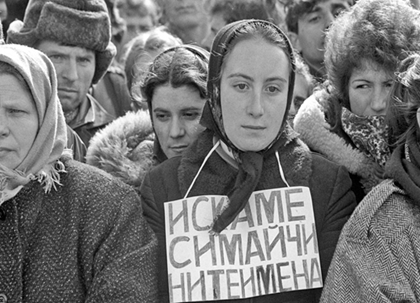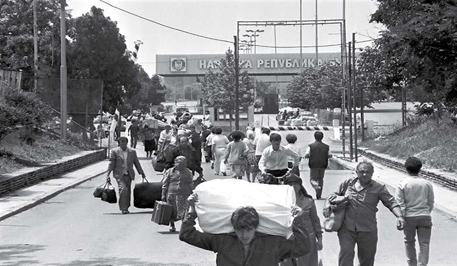
On the way towards a lesson plan
May 13, 2018In this blog post, we at the Sofia Platform would like to introduce some potential sources to you, along with the background behind them and the methodology that we used to choose them.
(Copyright 2013, Bursa Büyükşehir Belediyesi)
Questions:
- What do you think the people in the picture are doing, and when do you think this activity might have taken place? What could make people cross a border on foot, carrying their luggage with them?
- The country where this picture was taken, located in southeastern Europe, ceased to exist in this political form a few decades ago. Which one do you think it is, and what do you think happened to it?
- Who do you think these people might be? How do you imagine their lives might have evolved 1, 3, 5, or 10 years from the day when the photograph was taken?

(Available at: http://reflection-eu.info/bg/content/%D1%81%D1%8A%D0%B1%D0%B8%D1%82%D0%B8%D1%8Fevents)
The sign says, “We want our mothers’ names back”
Questions:
1. Who do you think are the people in the picture?
2. What do you think they are doing, and why?
3. When do you think this activity is taking place?
Commentary:
The so-called ‘Revival process,’ which was followed by the mass exodus of about 300,000 Bulgarians with a Turkish ethnic background to Turkey, is one of the most shameful periods in Bulgarian history. For centuries, Bulgarian Muslims and the Turkish minority have made up the largest ethnic and religious minority in Bulgaria, in the context of the Ottoman Empire and its aftermath. The culmination of the communist party’s assimilation agenda regarding the Bulgarian Turks was the Revival Process (1984-87), a re-naming campaign that forced those with Turkish or Arabic names to change them to Bulgarian names. It took place with the majority of the Bulgarian population unaware of the campaign. It provoked uproar and resistance among the Bulgarian Muslim communities, which was met with authoritarian measures by the communist party. The reaction by the Muslim minority, which became violent at times, further polarized and strengthened the negative stereotypes that both sides hold towards each other, even in the present day. Complex interethnic relations have underlined the political debate in Bulgaria, both before and after the events of the Revival Process. Even now, the Turkish minority in Bulgaria perceives the events as a direct ethnic attack by the communist regime.
Methodology:
The Revival Process of the late ‘80s in Bulgaria tells a story of communism that summarizes some of its most brutal aspects and exposes the contradictions between its oft-acclaimed peaceful ideology and the reality of its implementation. We chose pictures that describe different moments from the forceful re-naming process of the Bulgarian Turkish ethnic minority in the ‘80s, which resulted in the mass exodus of 300,000 of them to Turkey – the first time Bulgaria opened its border to the non-communist, NATO member state. When formulating the questions, we thought of three key things:
1. Historical context: in order to understand historical events, it is important to provide the necessary context. Questions pointing to the People’s Republic of Bulgaria which ceased to exist in that political form in 1989 offer a way of engaging the students in a conversation about what happens to a state when its political system is transformed, as well as what it means if the elites are willing to use force in order to stay in power.
2. The forceful policy of uniformity and othering: the questions pointing at the fate of the Bulgarian ethnic Turks give a starting point for a conversation about forceful uniformity, how othering occurs, and how enemies are constructed.
3. Legacies: this question is important, as it helps discuss how past events relate to the period following the collapse of communism, up until the present. As someone told me recently, if one had asked a Western European in the ‘90s where the next ethnic conflict would be in Europe, they would certainly have pointed to Bulgaria, less so than to the former Yugoslavia. It is worthwhile to look into why that has been prevented, and what lessons were learned, and what price was paid.

